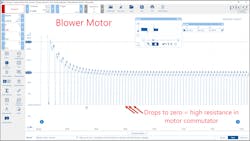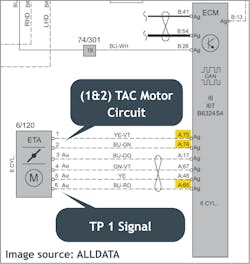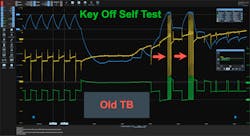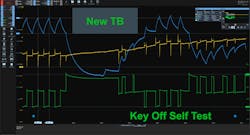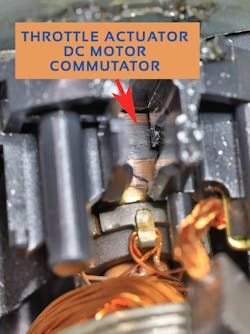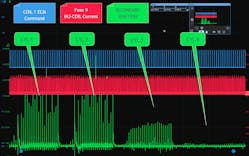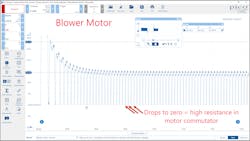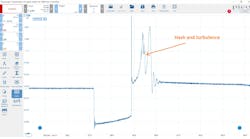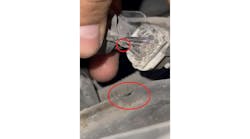Content brought to you by PTEN. To subscribe, click here.
Automotive technicians rely on a variety of tools to diagnose and troubleshoot problems surfacing on vehicle systems. Today, we're seeing vehicles with multiple network circuits containing high-speed data communications along with advanced powertrain controls. More than ever one of the most important tools in their arsenal is the lab scope, also known as an oscilloscope. Lab scopes are electronic testing devices that allow technicians to view and analyze electrical signals and their characteristics. In this article, we will discuss real-world examples using lab scopes to troubleshoot and diagnose problems in automotive systems.
There are a few basic knowledge elements one needs to have a decent understanding of if they are going to use the oscilloscope to aid them in troubleshooting and the first and most important question you will want to ask yourself is 'why.'
Important metrics:
- Sample rate — how often the scope is sampling the signal it is measuring.
- Voltage levels — the expected voltage range the scope will need to measure and display.
- Time base — the amount of time displayed on the screen.
Users need to understand that the time base setting on the scope can influence the sample rate. A slower sample rate may result in missed measurements of rapid voltage signal changes. Some scopes will allow some flexibility here where you can prioritize the sample rate within limitations. Typically, the more expensive the scope the more capable it is.
Essentially, a decent consumption of electrical circuit education along with lab scope training and network communication knowledge will provide today’s technician with the necessary skillset that will enable him or her to be successful today and well into the future. Additionally, one must always accept the fact that they are likely to find opportunities to learn more along the way through their diagnostic experiences. This will truly raise the value of your offering to the service industry and promote a strong career.
Case study No. 1: Throttle actuator control (TAC) challenges
Throttle-by-wire systems have been around for quite some time now and it’s likely you’ve already encountered complaints involving these. We had a 2013 Volvo XC60 that arrived with the following complaint:
Customer states that while driving the vehicle, they went to make a turn and the MIL suddenly came on, at that same point the vehicle seemed hesitant to shift into the next gear. The customer turned the vehicle off and started it up again, MIL light remained on but seemed to be driving normally.
The technician started the vehicle and confirmed that it appeared to be operating properly and the MIL was still illuminated.
Upon scanning the vehicle, the following DTCs were recorded within the ECM:
- 0x7E8: P050700 - Idle air control (IAC) system RPM higher than expected.
- 0x7E8: U016700 -Lost communication with vehicle immobilizer control module.
- 0x7E8: P061F00 - Internal control module throttle actuator controller performance.
- Channel 1 — TA473 - 60-amp current probe around the BU-GN (pin 74) wire
- Channel 3 — 1:1 voltage probe across pins 74 and 75 so we could monitor the half-bridge controls on the brushed DC motor
- Channel 4 — 1:1 voltage probe at pin 65 (TP1) referenced to ground
- Channel 1 — +/- 10A
- Channel 3 — +/- 50V DC
- Channel 4 — +/- 5V DC
- Sweep — 2 s/div
- Sample rate — 2.5MS/sec
Case study No. 2: Misfire analysis — secondary ignition coil over plug, cassette coil assy.
- 0x7E8: PO122 - Throttle/pedal position sensor 'A' circuit low (permanent)
- 0x7E8: P0171 - System too lean (bank one) (permanent)
- 0x7E8: P0223 - Throttle/pedal position sensor/switch 'B' circuit high (permanent)
- 0x7E8: P0300 - Random misfire detected (SES, pending, current, old, permanent, history)
- 0x7E8: P0597 - Thermostat heater control circuit/open (pending)
- 0x7E8: P0598 - Thermostat heater control circuit low (pending)
- 0x7E8: P0689 - ECM/PCM power relay sense circuit low (pending, history)
- 0x7E8: P1682 - Driver five line two (pending, current, history)
- 0x7E8: P2078 - Intake manifold tuning (IMT) valve position sensor/switch circuit high (pending)
